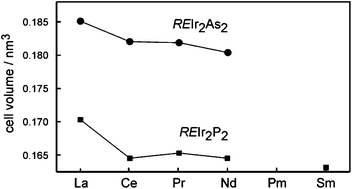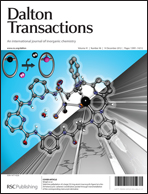The phosphides REIr2P2 (RE = La–Nd, Sm) and arsenides REIr2As2 (RE = La–Nd) were synthesized by a ceramic route via precursor compounds REIr2 with phosphorus and arsenic, respectively. Well-shaped single crystals were obtained from lead and bismuth fluxes, respectively. The nine pnictides crystallize with the tetragonal CaBe2Ge2 type structure, space group P4/nmm. The structures of CeIr2P2, SmIr2P2, LaIr2As2 and CeIr2As2 were refined from single crystal X-ray diffractometer data. The structures are composed of three-dimensional [Ir2P2] and [Ir2As2] networks in which the rare earth atoms fill cavities of coordination number 16 (8 P + 8 Ir). The phosphorus and arsenic atoms have tetrahedral and square pyramidal iridium coordination. Temperature dependent magnetic susceptibility measurements show intermediate cerium valence for CeIr2P2. The rare-earth and phosphorus local environments in LaIr2P2 are characterized further by 139La and 31P single and double resonance solid state nuclear magnetic resonance (NMR) spectroscopy. Strong 31P Knight shifts and extremely short spin-lattice relaxation times indicate that the bonding character of the phosphide species is strongly metallic. The two crystallographically distinct phosphorus sites are well-resolved in the 31P magic-angle spinning (MAS) spectrum and also differ significantly with respect to their effective magnetic shielding anisotropies. Unambiguous site assignments are accomplished on the basis of homonuclear 31P–31P magnetic dipole–dipole interactions, which can be measured in a site-resolved fashion in this compound using static 31P spin echo decay spectroscopy. The highly symmetric La environment in LaIr2P2 is characterized by a sharp 139La MAS-NMR spectrum, revealing rather weak nuclear electric quadrupole coupling. Furthermore, a second local environment is detected, which is characterized by stronger quadrupolar coupling and similar dipolar coupling strength with 31P as the regular site, according to 139La{31P} rotational echo double resonance (REDOR) NMR results. On the basis of these data we attribute this site to a La species next to a phosphorus vacancy. From the signal area of this resonance we deduce a composition LaIr2P1.90.

You have access to this article
 Please wait while we load your content...
Something went wrong. Try again?
Please wait while we load your content...
Something went wrong. Try again?


 Please wait while we load your content...
Please wait while we load your content...